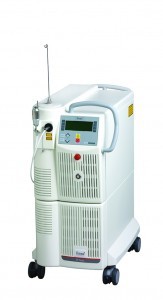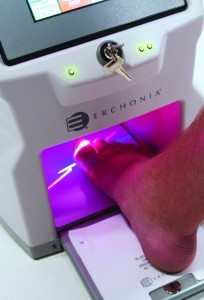Device-based antifungal therapy
Three separate groups in device-based therapies can be identified: high power lasers, diode lasers, and photodynamic therapy. Studies were performed in vitro and in vivo.
High power lasers
Although there are only few scientific papers published proving their accuracy, most pilot studies suggest that Nd:YAG laser treatment may be a valuable option. Vural et al tested the effectiveness of a number of light sources on inhibiting T. rubrum growth25. Only the nanosecond Q-switched Nd:YAG lasers of 1064 nm and 532 nm wavelengths were able to inhibit the growth of T. rubrum colonies, whereas intense pulsed light (IPL), pulsed dye laser, Erbium laser, and a long pulse KTP laser were all ineffective. According to Vural’s theory, Nd:YAG wavelengths are absorbed by xanthomegnin (532 nm), a red pigment abundant in T. rubrum cell walls and melanin (1064 nm) . Also, the nanosecond pulse duration of the Q-switched laser provides thermal shock, microcavitation, and acoustic shock to the fungal cells. Vural et al suggested that the length of pulse duration might explain why the KTP laser, with 532 nm wavelength and long pulse duration, was ineffective at inhibiting T. rubrum growth.
The mycological cure rate of 1064 nm lasers is reported to be between 51%26 and 100% 27. However, the results of different studies are hardly comparable and reproducible as they often lack control groups and are conducted on small numbers of patients. The preliminary results of a study by Wanitphakdeedecha et al 28, which followed the protocol described in the study by Kozarev 27, reported that 66% of patients were mycologically cured, thus failing to reproduce the results achieved by Kozarev et al ( i.e. 95.83% of negative mycological examination after 3 months post-therapy). It must be emphasised that one third of patients in the Wanitphakdeedecha study were infected with Scytalidium dimidiatum, which is more prevalent in Thailand, and 23% of patients suffered from reduced peripheral circulation. The treatment protocol usually requires one to four visits with a 4–6 week interval and two passes of laser irradiation administered at every visit. Fluencies vary from study to study: 14 J/cm2 26 to 223 J/cm2 29.
Manevich et al conducted an in vitro study to assess the safety of laser irradiation on the nail plate. They found that the difference between fluence required to eradicate fungi from under the nail plate (4.8 x 10 22 photons/s x m 2) and fluence that caused nail plate destruction (17 x10 22 photons/s x m 2) provided a safe therapeutic index30.
Advantages of laser therapy include an inability to induce microbial resistance to this form of therapy, it does not contribute to liver toxicity, and the treatment protocol ensures good patient compliance. The main disadvantage of laser use is pain during treatment. Large amounts of energy delivered to the nail plate causes a burning sensation, and nearly all patients report some level of pain during treatment26. This procedure requires trained personnel and access to laser devices. Cooling, heat delivery control (like in the Cooltouch laser), micropulses of irradiation that split the energy, and more variation in parameters help to avoid discomfort and will be essential to establish a standard laser therapy protocol in the future. Today, the proof of clinical efficacy is still under investigation as available studies lack consistency.
Diode laser light sources
Low energy laser light sources of 870 and 930 nm wavelength are also an available treatment option, such as the Noveon laser.

Figure 3 Fotona XP Focus, a versatile laser for onychomycosis treatment, as well as sub‑millisecond and long pulse treatment schemes
The in vitro studies by Bornstein et al provided a theoretical explanation for why this laser system would be effective. Using long pulses of irradiation for 12 minutes and a total energy of 7920 J in a protocol, they achieved 100% dead cells in liquid solutions with T. rubrum and C. albicans31. The authors observed radiation dose-related glutathione depletion in C. albicans cells and concluded that those wavelengths are responsible for singlet oxygen formation in the cells, but this observation requires further research.Landsman, who was investigating the clinical effectiveness of the Noveon laser found that only 38% of treated patients achieved mycological cure after three 6-minute treatments32. Although the in vitro and in vivo study designs are not comparable, nearly eight-times lower energy was administered to patients in the study by Landsman compared with the in vitro trial by Bornstein et al. Administration of irradiation through the nail plate may also decrease the effective energy reaching the nail bed, but comparative studies have never been made in this field.
A positive aspect of low energy lasers is the lack of thermal damage to tissues, as temperatures during irradiation remain in physiologic ranges. This method is also absolutely painless, but more research is required to conclusively verify the efficacy. The duration of therapy is longer and the cost is higher than that of the Nd:YAG method, owing to the necessary use of toe-clips. The fifth toenail can not be treated with this method.




